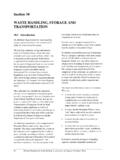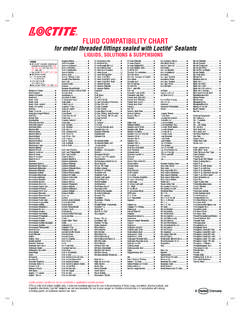Transcription of caustic scrubber and sulphuric acid tail gas options
1 1 Implementation of caustic Scrubbing System and sulphuric acid as an Alternate Tail gas Treating Systems M. Rameshni, President & CEO Rameshni & Associates Technology & Engineering (RATE) Monrovia, CA, USA Emissions regulations are getting tighter and there is increasing demand to achieve higher sulphur removal and recovery efficiency. The environmental regulatory agencies of many countries continue to promulgate more stringent standards for sulphur emissions from oil, gas, and chemical processing facilities. Typical sulphur recovery efficiencies for Claus plants are 90-96% for a two-stage, and 95-98% for a three-stage plant.
2 Most countries require sulphur recovery efficiencies in the range of to +% including typical tail gas treating units. To comply with both progressively tighter product purity specifications and stricter environmental regulation agencies; the sulphur recovery efficiencies of near 100% is required by some locations such as California, USA to obtain the construction permit for new or modified sulphur plants. There are many SCOTT type tail gas-amine units in operation and the standard allowable emissions has been 250 ppmv of SO2 for many years.
3 The improvement methods are available that could reduce SO2 emission from 250 ppmv to 30-50 ppmv. The World Bank regulation requires emissions of SO2 less than 150 mg/Nm3 (~50 ppmv) to approve the loan. However any improvement will increase the capital and operating cost of the facility; the balance has to be kept. The SCOTT type TGU Amine process for Claus tail gas treatment clearly represents Best Available Control Technology (BACT), potentially achieving +% overall sulphur recovery with emissions of < 10 ppmv H2S and 30-50 ppmv total sulphur as SO2 is achievable.
4 When concentration of impurities in the acid gas such as COS and CS2, H2S content, and feed gas composition, and finally treated gas specifications are established, the overall SRU / TGU scheme including type of amine a generic or formulated for a particular application is specified. Option 1- SRU/ TGU-Amine Design plus Forced Draft Incineration with caustic scrubber unit The followings design-steps will be taken in summary to achieve the maximum possible overall recovery in the conventional SRU/TGU-amine type unit. The details of the limitations and how to overcome them are discussed Design-Step 1 the implementations of these features will reduce the emission of SO2 from typical 250 ppmv to 30-50 ppm at the SOR (start-of-run) and EOR (end-of-run) respectively.
5 2 1. High Intensity SRU Burner for better destruction of ammonia, hydrocarbons and impurities 2. Use Titania catalyst at the bottom of the first SRU reactor bed and the alumina at the top. The volume of the Ti catalyst could be up to 50% of the total catalyst volume. 3. Using Titania catalyst on the second or third SRU reactor is not very effective due to lower operating temperature, but is evaluated case by case 4. Recycle the vent gas from the sulphur pit and the sulphur degassing to the front of SRU which traditionally were routed to the incinerator, it is very important the recycle gas to be routed to the proper location to prevent any cold spot or plugging as well as impact on the SRU recovery 5.
6 The modern improvements of using TGU low temperature catalyst and steam reheaters instead of fired inline burner has significant impact on COS and CS2 hydrolysis which the details are provided in this paper. To achieve 100% recovery, two options could be considered: 1) to use the conventional fired heater to make sure the operating temperature to the hydrogenation reactor is high enough or 2) to use dual steam reheaters instead of one by using superheated steam instead of saturated steam in the second reheater to achieve higher temperature to the hydrogenation reactor 6.
7 Select the formulated amine solvent instead of Generic MDEA to achieve the 10 ppmv of H2S from the absorber overhead, these amine solvents are described in detail in this paper such as HS-103, TG-10, MS-300 or Flexsorb SE plus The above implementations will improve the performance of SRU/TGU unit to achieve higher recovery by lowering the SO2 emission to 30-50 ppmv (SOR & EOR) of SO2. It is also meets the World Bank Standards. Design-Step 2- in this step the improvement will take place in the incinerator where we are able to reduce the SO2 emission from 30-50 ppmv (SOR and EOR) to less than 5 ppmv.
8 Forced draft thermal design incinerator is employed where the tail gas absorber overhead enters the incinerator and is heated by burning fuel gas in a low or ultra NOx incinerator burner to oxidize all the sulphur compounds to SO2. The gas leaving the incinerator is cooled by recovering heat in the incinerator waste heat boiler and by producing saturated or superheated high pressure steam. The outlet from the incinerator waste heat boiler enters the caustic scrubber to absorb the SO2 from the gas. The gas leaving the caustic scrubber will contains less than 5 ppmv of SO2 which is routed through a short stack to a safe location.
9 It may be required to heat the stack gas prior to emitting to the atmosphere to prevent condensation. In some cases gas/gas heat exchanger might be used to cool the gas entering the caustic system further and to heat the gas from the caustic scrubber . The spent caustic is sent to the water treatment system. 3 The effluent gas from the Incinerator Waste Heat Boiler is desuperheated in a venturi scrubber by intimate contact with a 10 wt % caustic solution. During the liquid vapor contact a portion of the SO2 is removed from the vapor and the gas is cooled.
10 The liquid-vapor mixture then flows to the caustic scrubber . The vapor flows up through the packed bed of the caustic scrubber against a countercurrent stream of 10 wt % caustic solution to scrub the remaining SO2 from the tail gas. The treated gas leaving the caustic scrubber will contain low ppm levels of SO2. Due to the temperature of the gas leaving the Incinerator Waste Heat Boiler there is a constant vaporization of water in the caustic scrubber which needs to be made up. This make up water is added to the column at the upper bubble trays to knock any remaining entrained caustic out of the vapor to minimize caustic loss.


